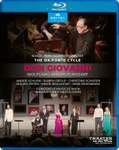|
Back
04/22/2021
Wolfgang Amadeus Mozart: Don Giovanni, K. 527
Andrè Schuen (Don Giovanni), Mika Kares (Il Commendatore, Masetto), Christine Schäffer (Donna Anna), Mauro Peter (Don Ottavio), Maite Beaumont (Donna Elvira), Ruben Drole (Leporello), Mari Eriksmoen (Zerlina), Arnold Schönberg Chor, Erwin Ortner (chorus master), Concentus Musicus Wien, Nikolaus Harnoncourt (conductor), Doris Maria Aigner (costume designer), Felix Breisach (scenic arrangement, video director)
Live recording: Theater an der Wien, Vienna, Austria (March 17 and 19, 2014) – 248’
Unitel-Classica (ENT) DVD 803908 (or Blu-ray BR 804004), picture format: NTSC 16.9 – Sound formats: Opera PCM stereo, DTS 5.1 – Region 0 (Distributed by Naxos of America) – Booklet in German, French and English – Subtitles in Italian, English, German, French, Korean and Japanese

   
This is the umpteenth recording of Don Giovanni under Nikolaus Harnoncourt. It is part of the “Da Ponte” project, presenting Mozart’s Le nozze di Figaro, Don Giovanni, and Così fan tutte at Vienna’s Theater an der Wien in 2014. Quite an ambitious venture it was, as the Austrian conductor demanded the same singers for the three operas, with, for each piece, one week of rehearsal followed by two performances, in a time constraint of thirty days for the entire undertaking. Needless to say that everyone must have been pushed to the limit, musicians, singers and technicians alike.
As often with Nikolas Harnoncourt, you never quite knew what to expect on almost every musical endeavor of his. Except for a quest for authenticity. Visually, this is a hybrid presentation, a little less frustrating than a concert version and much less than traditional staging. The set consists of three walls covered with portraits of the characters, a few chairs and music stands. Singers are wearing formal attire of the 1940s, tuxedos for men and evening gowns for women. What transpires here is an interesting work on spoken words. Recitatives are acted in keeping with feelings. Regardless of what the score says about the beat, drama is a priority, and recitatives sound like natural speech. Likewise, arias and duets focus on emotions; even if it means departing from accepted norms and “historical” performances. For example, the Act I duet Don Giovanni/Zerlina “Là ci darem la mano” is sung with emphasized seduction, à la Frank Sinatra.
The singing cast is beyond irreproachable, with voices that fit the prerequisites. Those young singers also show undeniable acting talent, as well as enthusiasm for being part of this “Da Ponte” cycle. As for the spicy period-instrument sound of the Concentus Musicus Wien, it sweeps you off your feet.
Whether the frustrating dryness of a concert version has been overcome is debatable, and whether this recording is a milestone in the history of Don Giovanni even more.
Christian Dalzon
|